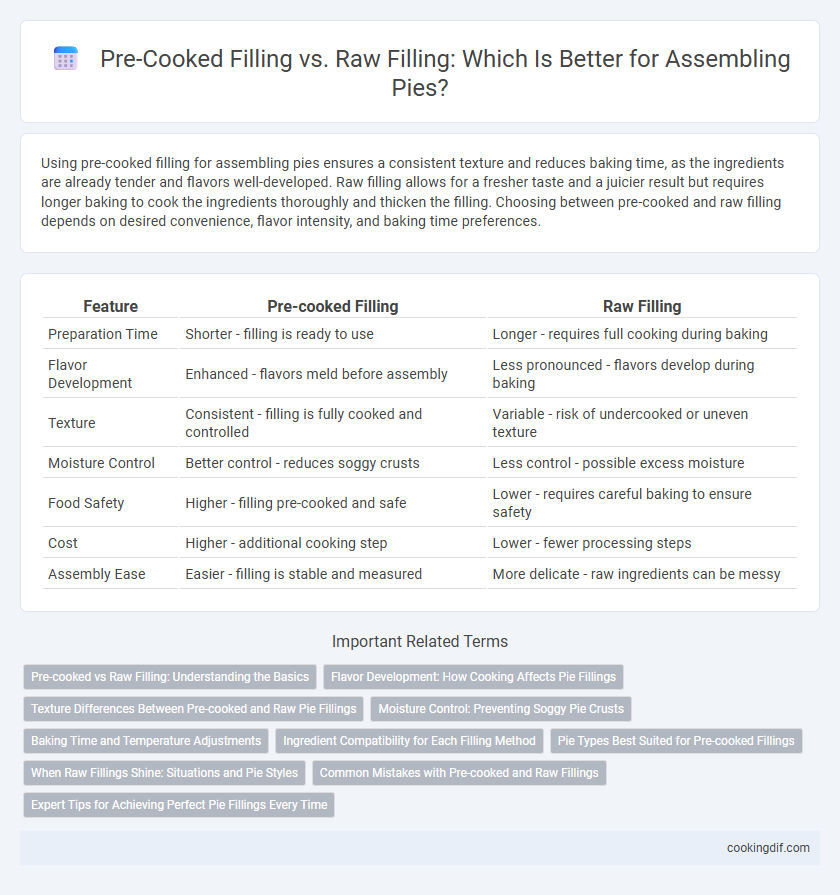Using pre-cooked filling for assembling pies ensures a consistent texture and reduces baking time, as the ingredients are already tender and flavors well-developed. Raw filling allows for a fresher taste and a juicier result but requires longer baking to cook the ingredients thoroughly and thicken the filling. Choosing between pre-cooked and raw filling depends on desired convenience, flavor intensity, and baking time preferences.
Table of Comparison
| Feature | Pre-cooked Filling | Raw Filling |
|---|---|---|
| Preparation Time | Shorter - filling is ready to use | Longer - requires full cooking during baking |
| Flavor Development | Enhanced - flavors meld before assembly | Less pronounced - flavors develop during baking |
| Texture | Consistent - filling is fully cooked and controlled | Variable - risk of undercooked or uneven texture |
| Moisture Control | Better control - reduces soggy crusts | Less control - possible excess moisture |
| Food Safety | Higher - filling pre-cooked and safe | Lower - requires careful baking to ensure safety |
| Cost | Higher - additional cooking step | Lower - fewer processing steps |
| Assembly Ease | Easier - filling is stable and measured | More delicate - raw ingredients can be messy |
Pre-cooked vs Raw Filling: Understanding the Basics
Pre-cooked fillings offer better moisture control and uniform texture, reducing the risk of soggy crusts in pies. Raw fillings retain more natural flavors and nutrients but require longer baking times to ensure thorough cooking and desirable consistency. Choosing between pre-cooked and raw fillings depends on the balance between convenience, flavor intensity, and textural outcomes in pie assembly.
Flavor Development: How Cooking Affects Pie Fillings
Pre-cooked pie fillings develop deeper, more concentrated flavors as the heat breaks down ingredients and blends spices enhances natural sweetness and reduces moisture. Raw fillings rely on the baking process to cook inside the pie, which can result in a fresher, lighter taste but sometimes underdeveloped or uneven flavors. Moisture management is crucial with raw fillings to prevent soggy crusts while pre-cooked fillings often provide better control over consistency and flavor intensity.
Texture Differences Between Pre-cooked and Raw Pie Fillings
Pre-cooked pie fillings offer a consistent, tender texture as the ingredients have already softened and melded together, preventing undercooked centers or watery crusts. Raw fillings, by contrast, retain a firmer and more varied texture because the baking process cooks the filling inside the pie, often resulting in a less uniform consistency. Choosing between pre-cooked and raw filling affects not only texture but also moisture control, impacting the overall pie structure and mouthfeel.
Moisture Control: Preventing Soggy Pie Crusts
Pre-cooked fillings reduce moisture release during baking, effectively preventing soggy pie crusts by evaporating excess liquid before assembly. Raw fillings tend to release more water as they cook inside the pie, increasing the risk of a wet crust and compromising texture. Using pre-cooked fruit or thickened mixtures ensures better moisture control and a crisp, well-structured pie crust.
Baking Time and Temperature Adjustments
Using pre-cooked filling in pies typically reduces baking time and requires a moderate oven temperature, around 350degF (175degC), to ensure the crust bakes evenly without overcooking the filling. Raw filling demands longer baking periods at higher temperatures, often near 375degF (190degC), to thoroughly cook the ingredients and develop proper texture. Adjusting baking time and temperature based on filling preparation guarantees a balanced crust and filling consistency, optimizing overall pie quality.
Ingredient Compatibility for Each Filling Method
Pre-cooked fillings offer enhanced ingredient compatibility by allowing flavors to meld and ingredients to soften before baking, preventing undercooked textures and ensuring uniform taste. Raw fillings rely on baking time within the pie crust to cook ingredients, demanding careful selection of components that can fully cook or retain desired texture during baking. Choosing between pre-cooked and raw fillings affects ingredient choices such as tougher vegetables or raw meats requiring prior cooking for safety and texture balance in the final pie.
Pie Types Best Suited for Pre-cooked Fillings
Pies such as pot pies, quiches, and savory meat pies are best suited for pre-cooked fillings to ensure even cooking and avoid soggy crusts. Pre-cooked fillings help control moisture levels, preserving the pie's structural integrity and enhancing flavor distribution. Fruit pies and custard-based pies typically use raw fillings, but heartier pies benefit from the texture and consistency of pre-cooked ingredients.
When Raw Fillings Shine: Situations and Pie Styles
Raw fillings shine in pies where the baking process allows ingredients to fully develop flavors and textures, such as fruit pies like apple, cherry, or blueberry. The natural juices release and thicken during baking, creating a rich, vibrant filling that precooked options often can't replicate. Overall, raw fillings are ideal for recipes requiring a fresh, home-cooked sensation and dynamic taste evolution in the oven.
Common Mistakes with Pre-cooked and Raw Fillings
Using pre-cooked filling in pies often leads to dry or overly dense results due to moisture loss during baking, while raw filling can cause undercooked centers and soggy crusts if not properly managed. Common mistakes include insufficient thickening agents in raw fillings and overcooking pre-cooked fillings, impacting texture and flavor balance. Ensuring correct filling temperature and consistency is essential to avoid these pitfalls and achieve a perfectly baked pie.
Expert Tips for Achieving Perfect Pie Fillings Every Time
Expert tips for achieving perfect pie fillings every time emphasize choosing pre-cooked filling for better texture control and reduced baking time, ensuring the fruit or ingredients retain their shape without excess moisture. Raw fillings offer a fresher flavor but require precise thickening agents like tapioca or cornstarch to prevent soggy crusts and uneven consistency. Balancing sugar levels and spices while pre-cooking or adjusting baking temperature guarantees a perfectly set pie filling with optimal taste and presentation.
Pre-cooked filling vs Raw filling for assembling pies Infographic

 cookingdif.com
cookingdif.com